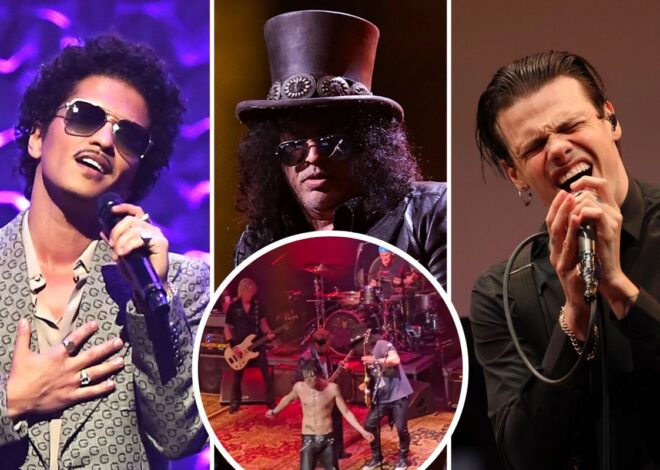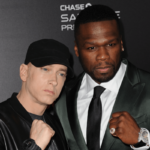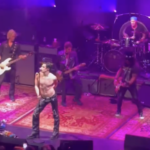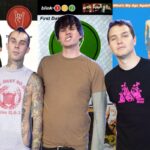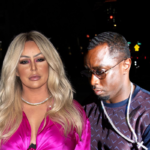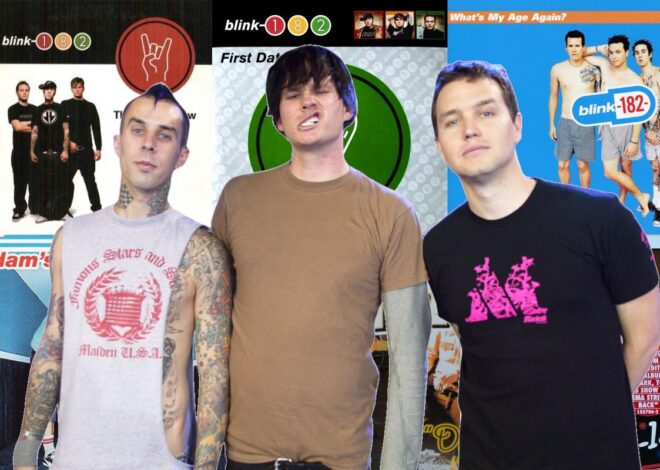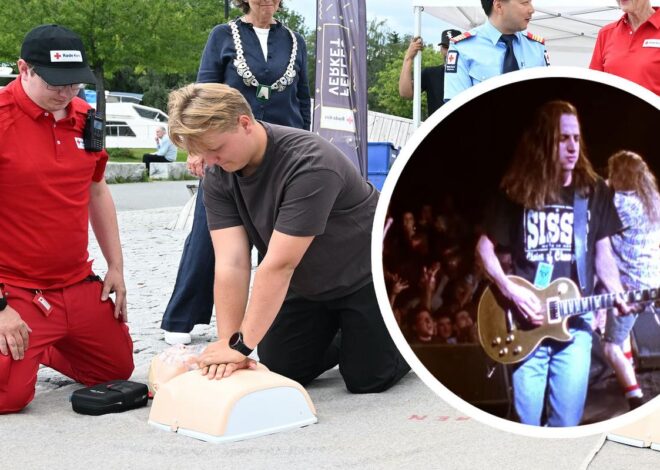
Rock Album Cover That ‘Haunted’ Bruce Dickinson + Inspired Him
Iron Maiden‘s Bruce Dickinson speaks with Full Metal Jackie about all he has going on this year and into next, as well as what 1970s rock album cover “haunted” him and eventually led him to discovering one of his most inspirational figures.
Within the chat, the singer also speaks about the recent reimagining of his Balls to Picasso solo album (now dubbed More Balls to Picasso) and how individual songs were impacted with the addition of horns and other standout features.
They also speak about how his solo band has come together in recent years and Bruce offers insight on what’s ahead for his solo band musically as well as the next steps for The Mandrake Project comic series. He projects a timeline into 2027 for another solo record, as well.
Check out more of the chat below.
It’s Full Metal Jackie and I am so excited to welcome back to the show one of metal’s truly great singers and entertainers, the legendary Bruce Dickinson. Bruce is taking us back but giving us a fresh spin with his Balls to Picasso solo album, hitting the road for his first extensive U.S. solo tour in 30 years and also gathering his comics work so far in The Mandrake Project: Year One.
Bruce, let’s start with the album. More Balls to Picasso is, in some sense, a reimagining though not a complete overhaul. What issue did you have with the initial recording and why was now the right time to bring it up to the standard you always wanted?
We always felt that the album was never as heavy as it should have been, as it was intended to be. That was ’cause we had so many different producers have their hands on it and everybody had different opinions and things like that. I think it just kind of got lost in the mix really, quite literally.
But the label now, the one that has Mandrake Project and everything, when they said, “Look. We wanna basically do the catalog and do it in Dolby Atmos and everything,” I said, “Well, maybe we could take the opportunity of doing a bit of an upgrade on Balls to Picasso and make it sound like the record it should have sounded like when we first put it out.”
So Brendan Duffy, who’s done all the Atmos mixes and has been doing that for all of my solo catalog, he said, “Well what do you want to do?” and I said, “Well, we wanna put some more guitars on it to beef it up. Hey let’s see what else we can do with various percussion bits.” Then we looked at the orchestra for “Tears of a Dragon” and also for “Change of Heart” and then we just went, “Well, let’s just go for broke. Let’s put a horn section on ‘Shoot All the Clowns.'”
So he called his buddies at Berklee College of Music, his two professors, because he was doing a PhD in music by correspondence whilst he was getting his five Grammys for doing something else and he said, “Oh, they’re really, really big fans, man. They really wanna do it. One’s a trombone guy, one’s a trumpet guy.” And they put this horn section together for “Shoot All the Clowns” which is just devastating. It’s fantastic.
So it is really an eclectic record to begin with, but it’s now a much deeper, darker and heavier eclectic record.
Bruce Dickinson, “Gods of War”
We just played you the new version of “Gods of War.” Let’s talk about this one, Bruce. When we talk about reimagining, it’s not just cranking up the guitars. You’re taking some interesting instrumental swings. On that one you’ve got the inclusion of some indigenous instruments from the Amazon you’ve brought into the mix. It was already a powerful drum song to begin with but this really adds a new layer. How vital was it to give “Gods of War” and some of the other material some unique instrumentation?
Funnily enough, all the indigenous instruments and the orchestration for “Tears” and “Change of Heart” actually all came from one guy, which was Antonio Teoli. He’s Brazilian and he lived in the rainforest for like a year or so and whilst he was there he went out with his tape recorder and recorded as many indigenous instruments as he could, because there’s loads of different ones. They’re making bird calls and things like that and everything.
So he built up a sound library of all that stuff and when I met him in L.A., because he was around when we were doing the Atmos mixes, he said, “You could really do something cool with that with some different types of percussion.” And I went, “Yeah, I’m down with that. Let’s see what you got.”
So he came up with the different sort of percussion elements of it [on “Gods of War”] and then he said, “Have you ever thought about doing an orchestra on ‘Tears’?” And I went, “Of course. That was the whole idea at the beginning. We never got round to having a real orchestra.” So he scored it and then recorded it and did the same for “Change of Heart” and it sounds unbelievable.
Bruce, while we’re speaking of some of the reimagined work on More Balls to Picasso, personally I love hearing a horn section in “Shoot All the Clowns.” I feel like there was more usage of horns in music in my youth and I enjoy how you employ it here. Obviously this is something you’ve had time over the years to consider and you have to trust those you work with as well. Where do the conversations start about what to add? Is it more experimentation and trial and error or just a gut feeling that this is what the song needs now?
What happened was I said, “You know, it would be great to put some horns on that track,” because it was always envisaged that we might try something like that but it was all done in such a damn hurry that we never got around to it. So then they came back and said, “Well, we’ve got this… we’ve done this … and see what you think. Is it too much?” And I was like, “No, no, no. No, no, no. Never too much. That’s great, I wanna hear more of it,” because it really smashes the groove along. It’s fantastic now. It really swings, that track.
Again, it makes the album a bit more eclectic. It’s not like a cookie cutter heavy metal album at all. There’s all kinds of stuff on that record that sounds for me at any rate and one or two commentators [have said] as well, “Hey, this sounds like a really contemporary, like a right now kind of record.”
The label were all over it because we did Mandrake Project and Mandrake was one of the most successful records for them last year worldwide. I toured that project round Europe, never toured it in the U.S., so that’s what this tour is doing. But we thought, “Well, we’ll plug more Balls into the tour as well,” because we do “Tears of the Dragon,” we’ve been doing “Gods of War,” “Laughing in the Hiding Bush,” stuff like that. We might have to add in “Cyclops” now, I’m not sure.
But we get a bit of a smorgasbord of stuff. We do stuff from Chemical Wedding, Accident of Birth and obviously stuff from Mandrake Project. In fact, the U.S. is gonna get “Shadow of the Gods,” which has never been played live before from Mandrake. It is probably the biggest track on the record that we’ve never played. So we’ll have some fun with that.
The band are all fired up, ready to go and that’s the band that I’m gonna be recording the new album with as well. So in ’26, early ’26, I’m in the studio with the band that you’ll be seeing in America, which is the band that toured in Europe and South America last year.
So that band is recording the album with me live. We’ve got 18 songs ready to go. And so we’re not gonna do 18 songs for the whole album, but we’ll just pick which ones we think are are the winners when we’ve done it. So it’s really exciting time.
Bruce Dickinson, “Shoot All the Clowns”
Bruce, the original Balls to Picasso album came at an interesting time in your career. The solo side of things were just blossoming for you and it was the first record with Roy Z. who has long been by your side. What was your recollections of that time in your life? Was that album cycle and all that came with it a rewarding experience? And did revisiting this album bring back certain things that you loved about this record?
The things I love about the record are the different flavors of music on the record. the breadth of it There’s everything from bits of Faith No More to sort of dark Peter Gabriel-y stuff to really industrial stuff. There’s rapping on it, there’s all kinds of stuff. It goes the whole gamut across pretty much everything. There’s ballads on it, there’s love songs on it, there’s brutal songs. it’s a really broad record and I’m very proud of it and I’m really pleased it’s gotten the revamp that it has.
Brendan’s done a fantastic job on the production and incidentally, Shay Baby, who was the original final producer of it, because the album went through a few different producers, Shay Baby was intimately involved with the mix. So he was giving us notes all the time about this, that and the other.
“Have you forgotten about this bit? Oh, there’s a bit in there that we always thought should’ve been a little bit louder.” We’ve not taken any of the original stuff away. Nothing has been taken away. But what we have put in is additional things, horns, some strings and guitars where appropriate, so we’ve beefed up the guitars, particularly rhythm guitars and some of the harmony guitars. But the solo guitars are all the same solos that they were from the same people.
We haven’t got anybody else to play any of the primary instruments. The drums sound fabulous, but those those are the original drums put through modern technology that just brings out that sound. Brendan’s like a magician, so honestly I can’t praise him enough how he’s done it.
Obviously you’ve been through America many a time with Maiden over the years, but this is the first extended solo run for you stateside in nearly 30 years. Add to that, a majority of your band has been added in the last couple of years. But you’ve got some great players as part of the group. What are your thoughts on how this band has come together and what you’ve got backing you up as you hit the road this year?
I didn’t do this selection of musicians with auditions or anything else like that. In fact, in a way, they kind of picked me. Dave Moreno I’ve known for ages and him and myself and Roy, we’ve worked together on albums for a while now. I’ve used his demo studio, the Doom Room. We actually recorded vocals and all kinds of stuff in there.
Then there was the keyboards and the keyboard element to it. Now, all the keyboards on “Tyranny of Souls” and pretty much all the keyboards that I’ve ever had, have been done by this Italian sort of like little multi-talented genius. He calls himself Mistheria. And I’d never met Mistheria until a few years back and all this keyboard stuff would just appear from Italy. And I was like, I said, “Who the hell is this guy? He’s just given us like 30 tracks of keyboards, every one of which would make an album on its own. Wow, who is this guy?” So I finally met Mistheria and we got along like a house on fire. In fact, I asked him to play piano, “Would you mind playing piano at my wedding?” And he did and it was awesome.
Then obviously we have the two guitarists, Chris De Clercq and Philip Naslund from Sweden and Tanya O’Callaghan on the bass.
Well, I met Tanya because we were doing an orchestral thing, which was like doing Jon Lord’s orchestra Concerto for Group and Orchestra, which was a classical piece. We had a band and originally it was gonna be Jon and Roger Glover from Deep Purple. And I did one show with Roger, but then he had to go off and do a Purple album, so he couldn’t do the European and the South American bit of the tour.
So that’s when in steps Tanya O’Callaghan, who had been playing with Whitesnake and I was just like, “Oh my God, this is awesome.” She’s great. She’s so professional, a really, really great player. Really lovely, just great musical chops and a lovely feel. And she sings, as we discovered, because we would do a little a capella version of “Navigate the Seas” which we did on a couple of American shows and we might even drag it out this time as well. So that’s how Tanya came along. I said, “Hey, look, what are you doing later?” “Do you fancy coming out on the road?” And she was like, “Yeah, sounds fun.” So that’s the, the rhythm section and the keyboards.
Bruce, we talked about your solo band, cover the rhythm section and keyboards. Who else are we missing?
Chris De Clercq, as it turned out, played some solos on Mandrake. I didn’t realize. I thought it was Roy and then Roy said, “No, actually it was this guy, Chris.” I went, “No kidding. I gotta meet this guy.” So Chris came along and I’d spent an afternoon jamming with him and thought, “Well, he’s great.” And then I thought, “Well, we need kinda like two guitar players, really.” And I thought back to my son, Austin, who was in As Lions and before that was in Rise to Remain and he’d played me some stuff he’d been writing with a Swedish guitar player and I went, “This guy’s amazing.” He had brilliant acoustic chops as well.
READ MORE: See Bruce Dickinson Play Iron Maiden Classic Live for the First Time
I met the guy in the pub later on and I just had him down as like a mental thing of what a nice guy, what a talent. And I said, “Don’t suppose you’d be interested in coming out on the road?” And it turned out that Philip was in Texas with the band doing, basically doing a session thing. And he said, “Look, I’ll swing by L.A.,” and he dropped by the Doom Room and played through basically the entire catalog of virtually everything I’d ever done. And I was like, “Okay, we should really do this.” So now that’s the band and I’ve played with them. We’ve been songwriting together.
We’ve been demoing in April. We’re recording in ’26 and hopefully in ’27, we’ll be out with the album and out on the road. But obviously, there’ll be other things happening in ’26 that I can’t talk about. But it’s very exciting.
Bruce, The Mandrake Project: Year One comes with an introduction by Kurt Sutter, the creator of Sons of Anarchy. How great was it to bring in Kurt with promotion for this comic series and get a chance to speak and interact with yet another creative storyteller?
I first met Kurt on a Zoom call during lockdown. So my buddy Sasha is a script writer in Los Angeles and we were talking on Zoom and he said, “Oh, you’re a big fan of Sons of Anarchy?” I went, “Yeah.” I said that, “That was the inspiration between the four biker Eddies of the Apocalypse in ‘Writing on the Wall.'” And I said, “I think it’s one of the greatest series I’ve ever seen” And he said, “Well why don’t we get Kurt on a Zoom just for the hell of it?” So that’s when I started talking to Kurt.
I ran the plot of The Mandrake Project past him and he said, “Yeah, that’s, that’s a really good story.” I said, “Well, how do I go about turning this into a comic, graphic novel, whatever you wanna call it.” He gave me some really, really great advice and then I went back to him when I developed the story and said, “Hey, I’ve done a few twists here. Is this too dark?” And he went, “Nope, never too dark.” So in a way he was really part responsible for the genesis of the whole thing. He’s a lovely guy and he’s a great writer. I so admire him.
Bruce, through this process of bringing The Mandrake Project: Year One together, there’s literally a little bit of one of your literary heroes involved. I have to say it was kind of a cool and interesting thing to do taking dirt from the grave of the late William Blake and including it with the ink that’s part of this collection. What was your introduction to Blake and why was his work so inspirational to you?
There was a band when I was a kid called Atomic Rooster and they had an album called Death Walks Behind You. And the gatefold was a complete full gatefold of Painting of Nebuchadnezzar by Blake. I didn’t know who it was. I didn’t know it was Blake. I didn’t know anything. All I know is this painting absolutely haunted me. It’s the king and he’s looking around and basically he’s turning into a beast in his head. He’s gone mad. It was extraordinary.
Atomic Rooster, Death Walks Behind You
atomic rooster death walks behind you
Then I realized later on that there were a few other paintings that were very similar and I went, “Oh my God, they’re all by the same guy.” So then I started doing a bit of reading about Blake and when I was doing The Chemical Wedding, I was kind of trying to just like channel him in terms of lyric writing and alchemy and things like that. [I wanted to] use his poetry to inspire lyrics and scenarios and things like that.
So he’s been a real inspiration to me. In fact, when they rededicated his grave, because they didn’t know exactly where he was buried, there was a gravestone that said, “Near this spot is buried poet and artist William Blake, a visionary William Blake and his wife,” but they didn’t know exactly where.
With the help of ground penetrating radar and everything else, they located the grave and they put a big slab on top of it, rededicated it and then I’d actually done a show with Iron Maiden the night before in the O2 which is like a 18,000 seater, we done two nights there.
So the following morning I was in Bunhill Fields graveyard with about 400 other crazy Blake fans and I was standing on top of a rock doing some singing. Because the graveyard doesn’t allow any electronic equipment at all, everything was acoustic. And then we all celebrated William’s new, new home and went away and got drunk.
Before we go, obviously we’ve got The Mandrake Project album touring and the corresponding comic series. They’ve been a big part of your life for the last few years, but as you’re always seemingly working, I wanted to check in to see if there’s an update on potential new music and and how does your schedule look for the next year or so?
There’s definitely new music. In April, I demoed 18 tracks with the band and we’re gonna be recording those tracks next January with a view to the album coming out maybe ’27 and then obviously touring through ’27.
I’m also kinda busy with some other things in ’26, which you’ll hear about soon that I can’t tell you about, but you’ll be happy. So there’s a lot of new music.
In terms of Mandrake Project, this first year of first four episodes is one book. There’s another eight episodes to go, so episodes 5, 6, 7 right now are in production in terms of artwork and everything. I’ve still gotta write the script for eight and that’ll be book two. Then we’re into the home stretch with what happens. I do actually know what happens in episode 12, but it’s how we get there that’s the exciting bit.
Thanks to Bruce Dickinson for the interview. The Mandrake Project album and comic as well as the reworked More Balls to Picasso are available through Dickinson’s Mandrake Project website. You can also stay up to date with Bruce Dickinson through his Instagram account, YouTube and Spotify. Find out where you can hear Full Metal Jackie’s weekend radio show here.
The 67 Best Rock + Metal Songs of 2024
Recapping the best rock and metal songs of 2024 so far.
Contributions by Jordan Blum, Chad Childers, Joe DiVita and Lauryn Schaffner.
Gallery Credit: Loudwire Staff

